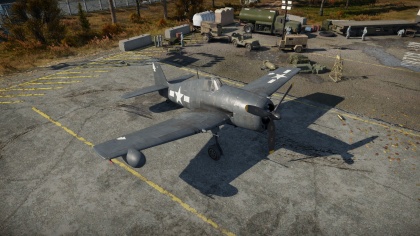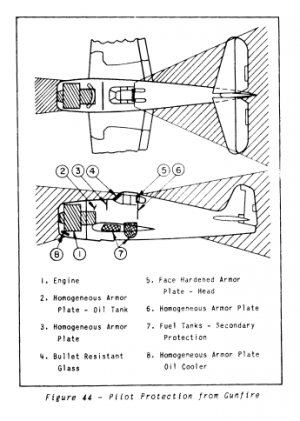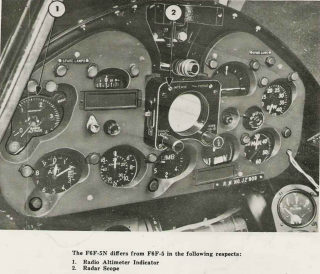Difference between pages "FlaRakPz 1" and "F6F-5N"
Colok76286 (talk | contribs) (→Mobility: Updated to new mobility template) |
godzilla5549 (talk | contribs) (added history and image of cockpit from pilot manual) |
||
| Line 1: | Line 1: | ||
| − | {{Specs-Card|code= | + | {{Specs-Card |
| + | |code=f6f-5n | ||
| + | |cockpit=334567/1111203 | ||
| + | }} | ||
| + | {{About | ||
| + | | about = American naval fighter '''{{PAGENAME}}''' | ||
| + | | other | ||
| + | | usage-1 = the French version | ||
| + | | link-1 = F6F-5N (France) | ||
| + | | usage-2 = other versions | ||
| + | | link-2 = F6F (Family) | ||
| + | }} | ||
== Description == | == Description == | ||
| − | <!--In the description, the first part should be about the history of the creation and combat usage of the | + | <!-- ''In the description, the first part should be about the history of and the creation and combat usage of the aircraft, as well as its key features. In the second part, tell the reader about the aircraft in the game. Insert a screenshot of the vehicle, so that if the novice player does not remember the vehicle by name, he will immediately understand what kind of vehicle the article is talking about.'' --> |
[[File:GarageImage_{{PAGENAME}}.jpg|420px|thumb|left]] | [[File:GarageImage_{{PAGENAME}}.jpg|420px|thumb|left]] | ||
{{break}} | {{break}} | ||
| − | The '''{{Specs|name}}''' is a rank {{Specs|rank}} | + | The '''{{Specs|name}}''' is a rank {{Specs|rank}} American naval fighter {{Battle-rating}}. It was introduced in [[Update 1.65 "Way of the Samurai"]]. |
== General info == | == General info == | ||
| + | === Flight performance === | ||
| + | ''Describe how the aircraft behaves in the air. Speed, manoeuvrability, acceleration and allowable loads - these are the most important characteristics of the vehicle.'' | ||
| + | |||
| + | {| class="wikitable" style="text-align:center" | ||
| + | |- | ||
| + | ! colspan="8" | Characteristics | ||
| + | |- | ||
| + | ! colspan="8" | ''Stock'' | ||
| + | |- | ||
| + | ! colspan="2" | Max Speed<br>(km/h at 5,730 m) | ||
| + | ! rowspan="2" | Max altitude<br>(meters) | ||
| + | ! colspan="2" | Turn time<br>(seconds) | ||
| + | ! colspan="2" | Rate of climb<br>(meters/second) | ||
| + | ! rowspan="2" | Take-off run<br>(meters) | ||
| + | |- | ||
| + | ! AB !! RB !! AB !! RB !! AB !! RB | ||
| + | |- | ||
| + | | 602 || 581 || {{Specs|ceiling}} || 22.2 || 23.1 || 8.1 || 8.1 || 399 | ||
| + | |- | ||
| + | ! colspan="8" | ''Upgraded'' | ||
| + | |- | ||
| + | ! colspan="2" | Max Speed<br>(km/h at 5,730 m) | ||
| + | ! rowspan="2" | Max altitude<br>(meters) | ||
| + | ! colspan="2" | Turn time<br>(seconds) | ||
| + | ! colspan="2" | Rate of climb<br>(meters/second) | ||
| + | ! rowspan="2" | Take-off run<br>(meters) | ||
| + | |- | ||
| + | ! AB !! RB !! AB !! RB !! AB !! RB | ||
| + | |- | ||
| + | | 661 || 629 || {{Specs|ceiling}} || 19.8 || 21.0 || 16.7 || 11.8 || 399 | ||
| + | |- | ||
| + | |} | ||
| + | |||
| + | ==== Details ==== | ||
| + | {| class="wikitable" style="text-align:center" | ||
| + | |- | ||
| + | ! colspan="5" | Features | ||
| + | |- | ||
| + | ! Combat flaps !! Take-off flaps !! Landing flaps !! Air brakes !! Arrestor gear | ||
| + | |- | ||
| + | | ✓ || ✓ || ✓ || X || ✓ <!-- ✓ --> | ||
| + | |- | ||
| + | |} | ||
| + | |||
| + | {| class="wikitable" style="text-align:center" | ||
| + | |- | ||
| + | ! colspan="5" | Limits | ||
| + | |- | ||
| + | ! rowspan="2" | Wing-break speed<br>(km/h) | ||
| + | ! rowspan="2" | Gear limit<br>(km/h) | ||
| + | ! rowspan="2" | Combat flaps<br>(km/h) | ||
| + | ! colspan="2" | Max Static G | ||
| + | |- | ||
| + | ! + !! - | ||
| + | |- | ||
| + | |803<!--{{Specs|destruction|constructions}}-->|| {{Specs|destruction|chassis}} || 510 || ~11 || ~4 | ||
| + | |- | ||
| + | |} | ||
| + | |||
| + | {| class="wikitable" style="text-align:center" | ||
| + | |- | ||
| + | ! colspan="4" | Optimal velocities | ||
| + | |- | ||
| + | ! Ailerons<br>(km/h) | ||
| + | ! Rudder<br>(km/h) | ||
| + | ! Elevators<br>(km/h) | ||
| + | ! Radiator<br>(km/h) | ||
| + | |- | ||
| + | | < 432 || < 420 || < 420 || > 420 | ||
| + | |- | ||
| + | |} | ||
| + | |||
| + | {| class="wikitable" style="text-align:center" | ||
| + | |- | ||
| + | ! colspan="3" | Compressor (RB/SB) | ||
| + | |- | ||
| + | ! colspan="3" | Setting 1 | ||
| + | |- | ||
| + | ! Optimal altitude | ||
| + | ! 100% Engine power | ||
| + | ! WEP Engine power | ||
| + | |- | ||
| + | | 518 m || 2,000 hp || 2,398 hp | ||
| + | |- | ||
| + | ! colspan="3" | Setting 2 | ||
| + | |- | ||
| + | ! Optimal altitude | ||
| + | ! 100% Engine power | ||
| + | ! WEP Engine power | ||
| + | |- | ||
| + | | 4,724 m || 1,800 hp || 2,158 hp | ||
| + | |- | ||
| + | ! colspan="3" | Setting 3 | ||
| + | |- | ||
| + | ! Optimal altitude | ||
| + | ! 100% Engine power | ||
| + | ! WEP Engine power | ||
| + | |- | ||
| + | | 6,400 m || 1,650 hp || 1,978 hp | ||
| + | |- | ||
| + | |} | ||
| + | |||
=== Survivability and armour === | === Survivability and armour === | ||
| − | '' | + | <!-- ''Examine the survivability of the aircraft. Note how vulnerable the structure is and how secure the pilot is, whether the fuel tanks are armoured, etc. Describe the armour, if there is any, and also mention the vulnerability of other critical aircraft systems.'' --> |
| − | + | * 3 mm steel - below the engine and above cooling system | |
| + | * 6.35 mm steel - behind the pilot | ||
| + | * 38 mm bulletproof glass - armoured windscreen | ||
| − | === | + | == Armaments == |
| − | <!-- '' | + | === Offensive armament === |
| + | [[File:F6F_Pilot_Protection.png|thumb|right|300px|A page from the F63/F6F pilots manual detailing protective angles against enemy weapons.]] | ||
| + | <!-- ''Describe the offensive armament of the aircraft, if any. Describe how effective the cannons and machine guns are in a battle, and also what belts or drums are better to use. If there is no offensive weaponry, delete this subsection.'' --> | ||
| + | {{main|AN/M2 (20 mm)|Browning M2 (12.7 mm)}} | ||
| − | {{ | + | The '''''{{PAGENAME}}''''' is armed with: |
| − | == | + | * 2 x 20 mm AN/M2 cannons, wing-mounted (231 rpg = 462 total) |
| − | === | + | * 4 x 12.7 mm Browning M2 machine guns, wing-mounted (400 rpg = 1,600 total) |
| − | '' | + | |
| + | === Suspended armament === | ||
| + | <!-- ''Describe the aircraft's suspended armament: additional cannons under the wings, bombs, rockets and torpedoes. This section is especially important for bombers and attackers. If there is no suspended weaponry remove this subsection.'' --> | ||
| + | {{main|AN-M65A1 (1,000 lb)|Tiny Tim|HVAR|Mk.13/44}} | ||
| + | |||
| + | The '''''{{PAGENAME}}''''' can be outfitted with the following ordnance: | ||
| + | |||
| + | * Without load | ||
| + | * 6 x HVAR rockets | ||
| + | * 2 x Tiny Tim rockets | ||
| + | * 2 x 1,000 lb AN-M65A1 bombs (2,000 lb total) | ||
| + | * 2 x 1,000 lb AN-M65A1 bombs + 6 x HVAR rockets (2,000 lb total) | ||
| + | * 1 x Mk.13/44 torpedo | ||
== Usage in battles == | == Usage in battles == | ||
| − | <!--''Describe the tactics of playing in | + | <!-- ''Describe the tactics of playing in an aircraft, the features of using aircraft in a team and advice on tactics. Refrain from creating a "guide" - do not impose a single point of view, but instead, give the reader food for thought. Examine the most dangerous enemies and give recommendations on fighting them. If necessary, note the specifics of the game in different modes (AB, RB, SB).'' --> |
| + | There was a reason the F6F was a standout fighter during World War II. As a fighter, it was versatile, not only as an aerial fighter but also as a ground pounder. | ||
| + | |||
| + | ;Aerial combat | ||
| + | |||
| + | * This F6F had a bit of weight to it which allowed it to perform well as a Boom & Zoom fighter. With a total of six guns, two M2 Browning machine guns and one 20 mm cannon in each wing, this fighter can take out enemy fighters without much trouble. | ||
| + | |||
| + | ;Ground attack | ||
| + | |||
| + | * The F6F excels in ground attack where it can be outfitted with either bombs or rockets. The 1,000 lb bombs have a devastating effect on ships and hardened structures not to mention vehicles which are clustered in a compact area. The agility of the aircraft makes it ideal to outfit rockets whether it is the HVAR or Tiny Tim rockets. The larger Tiny Tim rockets will pack a huge punch in armoured vehicles and ships while also able to damage bases (though nowhere near as well as bombs). HVAR rockets work best when reserved for armoured vehicles some hardened concrete structures and bombers. The rockets can be outfitted with contact fuses or time-delayed fuses. | ||
| − | ; | + | ;Naval attack |
| − | The | + | * The previously mentioned weapons for both aerial and ground attack can be utilised with great success in the naval arena as all weapons can cause damage to naval aircraft and ships. The F6F can carry a single specialised naval weapon, a Mk.13/44 torpedo which requires a slow and low approach to a ship to ensure the torpedo does not sink nor miss its target. While this is vulnerable and comprising to fly at a ship shooting back, a torpedo on target can yield a sunken ship. |
| + | |||
| + | ===Radars=== | ||
| + | {{main|AN/APS-6}} | ||
| + | The F6F-5N is equipped with an [[AN/APS-6]] search and tracking radar. The radar is mounted in a pod under the right wing tip. | ||
| + | |||
| + | {| class="wikitable" style="text-align:center" | ||
| + | ! colspan="4" | [[AN/APS-6]] - Target Detection Radar | ||
| + | |- | ||
| + | ! {{Annotation|Maximum<br/>Detection<br/>Range|The maximum possible range at which a target can be detected}} | ||
| + | ! {{Annotation|Guaranteed<br/>Detection<br/>Range|The range, below which, detection of a target is practically guaranteed}} | ||
| + | ! {{Annotation|Max Azimuth<br/>Scan Angle|How far to each side the radar can scan (widest search mode)}} | ||
| + | ! {{Annotation|Max Elevation<br/>Scan Angle|How far up and down the radar can scan (widest search mode)}} | ||
| + | |- | ||
| + | | 60,000 m<br />(theoretical) || 7,200 m || ±60° || ±60° | ||
| + | |- | ||
| + | ! colspan="4" | [[AN/APS-6]] - Target Tracking Radar | ||
| + | |- | ||
| + | ! {{Annotation|Maximum<br/>Tracking<br/>Range|The maximum range at which a target can be tracked}} | ||
| + | ! {{Annotation|Minimum<br/>Tracking<br/>Range|The range below which targets cannot be tracked by the radar}} | ||
| + | ! {{Annotation|Azimuth Tracking<br/>Angle|How far to each side the radar can track a target}} | ||
| + | ! {{Annotation|Elevation Tracking<br/>Angle|How far up and down the radar can track a target}} | ||
| + | |- | ||
| + | | 1,000 m || 150 m || ±15° || ±15° | ||
| + | |- | ||
| + | |} | ||
| + | |||
| + | === Manual Engine Control === | ||
| + | {| class="wikitable" style="text-align:center" | ||
| + | |- | ||
| + | ! colspan="7" | MEC elements | ||
| + | |- | ||
| + | ! rowspan="2" | Mixer | ||
| + | ! rowspan="2" | Pitch | ||
| + | ! colspan="3" | Radiator | ||
| + | ! rowspan="2" | Supercharger | ||
| + | ! rowspan="2" | Turbocharger | ||
| + | |- | ||
| + | ! Oil !! Water !! Type | ||
| + | |- | ||
| + | | Not controllable || Controllable<br>Not auto controlled || Controllable<br>Not auto controlled || Controllable<br>Not auto controlled || Separate || Controllable<br>3 gears || Not controllable | ||
| + | |- | ||
| + | |} | ||
| + | |||
| + | === Modules === | ||
| + | {| class="wikitable" | ||
| + | ! Tier | ||
| + | ! colspan="2" | Flight performance | ||
| + | ! Survivability | ||
| + | ! colspan="2" | Weaponry | ||
| + | |- | ||
| + | | I | ||
| + | | Fuselage repair | ||
| + | | Radiator | ||
| + | | | ||
| + | | Offensive 12 mm | ||
| + | | ITC mk.III | ||
| + | |- | ||
| + | | II | ||
| + | | | ||
| + | | Compressor | ||
| + | | Airframe | ||
| + | | New 12 mm MGs | ||
| + | | FRC mk.2 | ||
| + | |- | ||
| + | | III | ||
| + | | Wings repair | ||
| + | | Engine | ||
| + | | | ||
| + | | Offensive 20 mm | ||
| + | | LFRC mk.12 | ||
| + | |- | ||
| + | | IV | ||
| + | | | ||
| + | | Engine injection | ||
| + | | Cover | ||
| + | | New 20 mm cannons | ||
| + | | FLBC mk.1 | ||
| + | |- | ||
| + | |} | ||
| + | |||
| + | Payload modules unlock the following: | ||
| + | |||
| + | * ITC mk.III: One torpedo | ||
| + | * FRC mk.2: Six HVAR rockets | ||
| + | * LFRC mk.12: Two Tiny Tims | ||
| + | * FLBC mk.1: Two 1,000 lb AN-M65A1 bombs | ||
=== Pros and cons === | === Pros and cons === | ||
| − | <!--Summarise and briefly evaluate the vehicle in terms of its characteristics and combat effectiveness. Mark its pros and cons in | + | <!-- ''Summarise and briefly evaluate the vehicle in terms of its characteristics and combat effectiveness. Mark its pros and cons in the bulleted list. Try not to use more than 6 points for each of the characteristics. Avoid using categorical definitions such as "bad", "good" and the like - use substitutions with softer forms such as "inadequate" and "effective".'' --> |
'''Pros:''' | '''Pros:''' | ||
| − | * Has | + | * Has 2 x 20 mm cannons |
| − | * | + | * Great variety of weapons for any map, aerial combat, ground attack and maps with naval ships |
| − | * | + | * Decent climb rate and manoeuvrability |
| − | * | + | * Has a search and tracking radar |
| + | * Workhorse naval fighter | ||
'''Cons:''' | '''Cons:''' | ||
| − | * | + | * Slower than the standard F6F-5 |
| − | * | + | * Not as energy-efficient on a zoom climb like a P-47 |
| − | * | + | * Overall worse performance than F6F |
== History == | == History == | ||
| − | + | <!--Describe the history of the creation and combat usage of the aircraft in more detail than in the introduction. If the historical reference turns out to be too long, take it to a separate article, taking a link to the article about the vehicle and adding a block "/ History" (example: <nowiki>https://wiki.warthunder.com/(Vehicle-name)/History</nowiki>) and add a link to it here using the <code>main</code> template. Be sure to reference text and sources by using <code><nowiki><ref></ref></nowiki></code>, as well as adding them at the end of the article with <code><nowiki><references /></nowiki></code>. This section may also include the vehicle's dev blog entry (if applicable) and the in-game encyclopedia description (under <code><nowiki>=== In-game description ===</nowiki></code>, also if applicable).--> | |
| + | [[File:F6F 5N Cockpit Manual.png|thumb|right|320px|A page from the F6F Hellcat Pilot's Manual showing the differences found in the F6F-5N cockpit, with the radio altimeter indicator and radar scope being pointed out.]] | ||
| + | The F6F-5N was a modification of the standard F6F-5 for use as a night fighter. These aircraft were fitted with additional equipment in the form of a radio altimeter and radar. The Westinghouse AN/APS-6 radar was installed on the starboard wing of the F6F-5N, with units being completed in middle and late 1944. The APS-6 served as a method to search and destroy hostile aircraft in conditions with zero visibility, with data being displayed in a standard B-scope view of the target azimuth on the x-axis and target range on the y-axis. Aside from target search and tracking, the APS-6 could also be used in a navigation role by tracking a radar emitter or beacon with a search range of up to 100 miles.<ref name="ibiblio" /> Due to the simplifications from the earlier AN/APS-4 radar, the APS-6 was small enough to be installed in single-engine aircraft which allowed for independent action among night fighters. Another feature of the F6F-5N was the Type GR-1 automatic pilot, which gave pilots the ability to maintain a stable flight attitude with minimal input. Just as with the F6F-5, the -5N used the Pratt & Whitney R-2800-10W and had provisions to used a mixed armament of 2x 20 mm M2 cannons and 4x .50 cal Browning machine guns. The F6F-5N is noted as being one of the better American night fighters during World War II and was chosen to be a night fighter over other aircraft such as the F4U Corsair.<ref name="ibiblio" /> | ||
== Media == | == Media == | ||
| − | ''Excellent additions to the article would be video guides, screenshots from the game, and photos.'' | + | <!-- ''Excellent additions to the article would be video guides, screenshots from the game, and photos.'' --> |
| + | <div><ul> | ||
| + | <li style="display: inline-block;"> [[File:F6F_FN_and_Tiny_Tim.png|thumb|none|350px|An underside view of a '''{{PAGENAME}}''' carrying two [[Tiny Tim]] rockets. These rockets had to be released before igniting so to clear the propeller arc.]]</li> | ||
| + | <li style="display: inline-block;"> [[File:F6F_FN_firing_Tiny_Tim.png|thumb|none|375px|A view of a '''{{PAGENAME}}''' firing off a [[Tiny Tim]] rocket at an enemy target.]]</li> | ||
| + | <li style="display: inline-block;"> [[File:Tiny_Tim_shackle.png|thumb|none|320px|A side view of the shackle connection of the [[Tiny Tim]] rocket to the external pylon of the '''{{PAGENAME}}'''.]]</li> | ||
| + | </ul></div> | ||
== See also == | == See also == | ||
''Links to the articles on the War Thunder Wiki that you think will be useful for the reader, for example:'' | ''Links to the articles on the War Thunder Wiki that you think will be useful for the reader, for example:'' | ||
| − | * ''reference to the series of the | + | * ''reference to the series of the aircraft;'' |
* ''links to approximate analogues of other nations and research trees.'' | * ''links to approximate analogues of other nations and research trees.'' | ||
== External links == | == External links == | ||
| − | + | <!--Paste links to sources and external resources, such as:'' | |
* ''topic on the official game forum;'' | * ''topic on the official game forum;'' | ||
| − | * ''encyclopedia page on the | + | * ''encyclopedia page on the aircraft;'' |
| − | * ''other literature.'' | + | * ''other literature.--> |
| + | * AviationShoppe link for '''[https://aviationshoppe.com/manuals/grumman_f6f_flight_manual/f6f.html Grumman F6F Hellcat Pilot's Manual]''' | ||
| + | * Ibiblio HyperWar link for '''[https://ibiblio.org/hyperwar/USN/ref/NightFighterRadars/USNFRadar2.html "The AN/APS-6 Aircraft Radar"]''' | ||
| + | |||
| + | == References == | ||
| + | <references> | ||
| + | <ref name="ibiblio">"The AN/APS-6 Aircraft Radar" in ''Westinghouse in World War 2: Radio and X-ray Divsions,'' Westinghouse Electric & Mfg.Co., Inc, 1946.</ref> | ||
| + | </references> | ||
| − | {{ | + | {{AirManufacturer Grumman}} |
| + | {{USA fighters}} | ||
Revision as of 20:51, 1 March 2020
Contents
| This page is about the American naval fighter F6F-5N. For the French version, see F6F-5N (France). For other versions, see F6F (Family). |
Description
The F6F-5N Hellcat is a rank III American naval fighter
with a battle rating of 5.0 (AB) and 4.3 (RB/SB). It was introduced in Update 1.65 "Way of the Samurai".
General info
Flight performance
Describe how the aircraft behaves in the air. Speed, manoeuvrability, acceleration and allowable loads - these are the most important characteristics of the vehicle.
| Characteristics | |||||||
|---|---|---|---|---|---|---|---|
| Stock | |||||||
| Max Speed (km/h at 5,730 m) |
Max altitude (meters) |
Turn time (seconds) |
Rate of climb (meters/second) |
Take-off run (meters) | |||
| AB | RB | AB | RB | AB | RB | ||
| 602 | 581 | 11000 | 22.2 | 23.1 | 8.1 | 8.1 | 399 |
| Upgraded | |||||||
| Max Speed (km/h at 5,730 m) |
Max altitude (meters) |
Turn time (seconds) |
Rate of climb (meters/second) |
Take-off run (meters) | |||
| AB | RB | AB | RB | AB | RB | ||
| 661 | 629 | 11000 | 19.8 | 21.0 | 16.7 | 11.8 | 399 |
Details
| Features | ||||
|---|---|---|---|---|
| Combat flaps | Take-off flaps | Landing flaps | Air brakes | Arrestor gear |
| ✓ | ✓ | ✓ | X | ✓ |
| Limits | ||||
|---|---|---|---|---|
| Wing-break speed (km/h) |
Gear limit (km/h) |
Combat flaps (km/h) |
Max Static G | |
| + | - | |||
| 803 | 510 | ~11 | ~4 | |
| Optimal velocities | |||
|---|---|---|---|
| Ailerons (km/h) |
Rudder (km/h) |
Elevators (km/h) |
Radiator (km/h) |
| < 432 | < 420 | < 420 | > 420 |
| Compressor (RB/SB) | ||
|---|---|---|
| Setting 1 | ||
| Optimal altitude | 100% Engine power | WEP Engine power |
| 518 m | 2,000 hp | 2,398 hp |
| Setting 2 | ||
| Optimal altitude | 100% Engine power | WEP Engine power |
| 4,724 m | 1,800 hp | 2,158 hp |
| Setting 3 | ||
| Optimal altitude | 100% Engine power | WEP Engine power |
| 6,400 m | 1,650 hp | 1,978 hp |
Survivability and armour
- 3 mm steel - below the engine and above cooling system
- 6.35 mm steel - behind the pilot
- 38 mm bulletproof glass - armoured windscreen
Armaments
Offensive armament
The F6F-5N is armed with:
- 2 x 20 mm AN/M2 cannons, wing-mounted (231 rpg = 462 total)
- 4 x 12.7 mm Browning M2 machine guns, wing-mounted (400 rpg = 1,600 total)
Suspended armament
The F6F-5N can be outfitted with the following ordnance:
- Without load
- 6 x HVAR rockets
- 2 x Tiny Tim rockets
- 2 x 1,000 lb AN-M65A1 bombs (2,000 lb total)
- 2 x 1,000 lb AN-M65A1 bombs + 6 x HVAR rockets (2,000 lb total)
- 1 x Mk.13/44 torpedo
Usage in battles
There was a reason the F6F was a standout fighter during World War II. As a fighter, it was versatile, not only as an aerial fighter but also as a ground pounder.
- Aerial combat
- This F6F had a bit of weight to it which allowed it to perform well as a Boom & Zoom fighter. With a total of six guns, two M2 Browning machine guns and one 20 mm cannon in each wing, this fighter can take out enemy fighters without much trouble.
- Ground attack
- The F6F excels in ground attack where it can be outfitted with either bombs or rockets. The 1,000 lb bombs have a devastating effect on ships and hardened structures not to mention vehicles which are clustered in a compact area. The agility of the aircraft makes it ideal to outfit rockets whether it is the HVAR or Tiny Tim rockets. The larger Tiny Tim rockets will pack a huge punch in armoured vehicles and ships while also able to damage bases (though nowhere near as well as bombs). HVAR rockets work best when reserved for armoured vehicles some hardened concrete structures and bombers. The rockets can be outfitted with contact fuses or time-delayed fuses.
- Naval attack
- The previously mentioned weapons for both aerial and ground attack can be utilised with great success in the naval arena as all weapons can cause damage to naval aircraft and ships. The F6F can carry a single specialised naval weapon, a Mk.13/44 torpedo which requires a slow and low approach to a ship to ensure the torpedo does not sink nor miss its target. While this is vulnerable and comprising to fly at a ship shooting back, a torpedo on target can yield a sunken ship.
Radars
The F6F-5N is equipped with an AN/APS-6 search and tracking radar. The radar is mounted in a pod under the right wing tip.
| AN/APS-6 - Target Detection Radar | |||
|---|---|---|---|
| Maximum Detection Range |
Guaranteed Detection Range |
Max Azimuth Scan Angle |
Max Elevation Scan Angle |
| 60,000 m (theoretical) |
7,200 m | ±60° | ±60° |
| AN/APS-6 - Target Tracking Radar | |||
| Maximum Tracking Range |
Minimum Tracking Range |
Azimuth Tracking Angle |
Elevation Tracking Angle |
| 1,000 m | 150 m | ±15° | ±15° |
Manual Engine Control
| MEC elements | ||||||
|---|---|---|---|---|---|---|
| Mixer | Pitch | Radiator | Supercharger | Turbocharger | ||
| Oil | Water | Type | ||||
| Not controllable | Controllable Not auto controlled |
Controllable Not auto controlled |
Controllable Not auto controlled |
Separate | Controllable 3 gears |
Not controllable |
Modules
| Tier | Flight performance | Survivability | Weaponry | ||
|---|---|---|---|---|---|
| I | Fuselage repair | Radiator | Offensive 12 mm | ITC mk.III | |
| II | Compressor | Airframe | New 12 mm MGs | FRC mk.2 | |
| III | Wings repair | Engine | Offensive 20 mm | LFRC mk.12 | |
| IV | Engine injection | Cover | New 20 mm cannons | FLBC mk.1 | |
Payload modules unlock the following:
- ITC mk.III: One torpedo
- FRC mk.2: Six HVAR rockets
- LFRC mk.12: Two Tiny Tims
- FLBC mk.1: Two 1,000 lb AN-M65A1 bombs
Pros and cons
Pros:
- Has 2 x 20 mm cannons
- Great variety of weapons for any map, aerial combat, ground attack and maps with naval ships
- Decent climb rate and manoeuvrability
- Has a search and tracking radar
- Workhorse naval fighter
Cons:
- Slower than the standard F6F-5
- Not as energy-efficient on a zoom climb like a P-47
- Overall worse performance than F6F
History
The F6F-5N was a modification of the standard F6F-5 for use as a night fighter. These aircraft were fitted with additional equipment in the form of a radio altimeter and radar. The Westinghouse AN/APS-6 radar was installed on the starboard wing of the F6F-5N, with units being completed in middle and late 1944. The APS-6 served as a method to search and destroy hostile aircraft in conditions with zero visibility, with data being displayed in a standard B-scope view of the target azimuth on the x-axis and target range on the y-axis. Aside from target search and tracking, the APS-6 could also be used in a navigation role by tracking a radar emitter or beacon with a search range of up to 100 miles.[1] Due to the simplifications from the earlier AN/APS-4 radar, the APS-6 was small enough to be installed in single-engine aircraft which allowed for independent action among night fighters. Another feature of the F6F-5N was the Type GR-1 automatic pilot, which gave pilots the ability to maintain a stable flight attitude with minimal input. Just as with the F6F-5, the -5N used the Pratt & Whitney R-2800-10W and had provisions to used a mixed armament of 2x 20 mm M2 cannons and 4x .50 cal Browning machine guns. The F6F-5N is noted as being one of the better American night fighters during World War II and was chosen to be a night fighter over other aircraft such as the F4U Corsair.[1]
Media
-
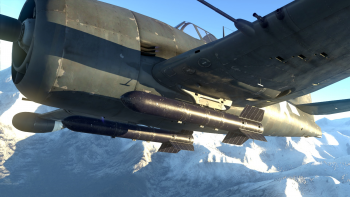 An underside view of a F6F-5N carrying two Tiny Tim rockets. These rockets had to be released before igniting so to clear the propeller arc.
An underside view of a F6F-5N carrying two Tiny Tim rockets. These rockets had to be released before igniting so to clear the propeller arc. -
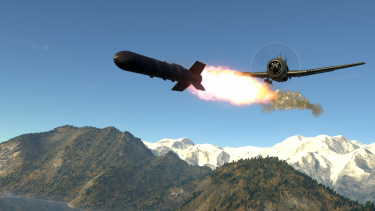 A view of a F6F-5N firing off a Tiny Tim rocket at an enemy target.
A view of a F6F-5N firing off a Tiny Tim rocket at an enemy target. -
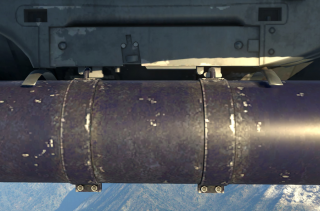 A side view of the shackle connection of the Tiny Tim rocket to the external pylon of the F6F-5N.
A side view of the shackle connection of the Tiny Tim rocket to the external pylon of the F6F-5N.
See also
Links to the articles on the War Thunder Wiki that you think will be useful for the reader, for example:
- reference to the series of the aircraft;
- links to approximate analogues of other nations and research trees.
External links
- AviationShoppe link for Grumman F6F Hellcat Pilot's Manual
- Ibiblio HyperWar link for "The AN/APS-6 Aircraft Radar"
References
| Grumman Aircraft Engineering Corporation | |
|---|---|
| Fighters | |
| F3F | F3F-2 · Galer's F3F-2 |
| F4F Wildcat | F4F-3 · F4F-4 |
| XF5F Skyrocket | XF5F · XP-50 |
| F6F Hellcat | F6F-5 · F6F-5N |
| F7F Tigercat | F7F-1 · F7F-3 |
| F8F Bearcat | F8F-1 · F8F-1B |
| Jet Fighters | |
| F9F Panther/Cougar | F9F-2 · F9F-5 · F9F-8 |
| F-11 Tiger | F11F-1 |
| F-14 Tomcat | F-14A Early · F-14B |
| Jet Strike Aircraft | |
| A-6 Intruder | A-6E TRAM |
| Bombers | TBF-1C |
| Export | ▄Martlet Mk IV · ▄F6F-5 · ▄F6F-5N · ▄F8F-1B · ▄Avenger Mk II · ▄Hellcat Mk II |
| USA fighters | |
|---|---|
| P-26 Peashooter | P-26A-33 · P-26A-34 · P-26A-34 M2 · P-26B-35 |
| P-36 Hawk | P-36A · Rasmussen's P-36A · P-36C · ○P-36C · P-36G |
| P-39 Airacobra | P-400 · P-39N-0 · P-39Q-5 |
| P-40 | P-40C · P-40E-1 · P-40E-1 TD · P-40F-10 |
| P-43 Lancer | P-43A-1 |
| P-47 Thunderbolt | P-47D-22-RE · P-47D-25 · P-47D-28 · P-47M-1-RE · ⋠P-47M-1-RE · P-47N-15 |
| P-51 Mustang | P-51 · P-51A (Thunder League) · P-51C-10 · P-51D-5 · P-51D-10 · P-51D-20-NA · P-51D-30 · P-51H-5-NA |
| P-63 Kingcobra | P-63A-5 · P-63A-10 · P-63C-5 · ␠Kingcobra |
| Prototypes | XP-55 |
| F2A Buffalo | F2A-1 · Thach's F2A-1 · F2A-3 |
| BF2C | BF2C-1 |
| F3F | F3F-2 · Galer's F3F-2 |
| F4F Wildcat | F4F-3 · F4F-4 |
| F4U Corsair | F4U-1A · F4U-1A (USMC) · F4U-1D · F4U-1C · F4U-4 · F4U-4B · F4U-4B VMF-214 · F2G-1 |
| F6F Hellcat | F6F-5 · F6F-5N |
| F8F Bearcat | F8F-1 · F8F-1B |
| Other countries | ▃Ki-43-II · ▃Ki-61-Ib · ▃A6M2 · ▃Bf 109 F-4 · ▃Fw 190 A-8 · ▃Spitfire LF Mk IXc |



